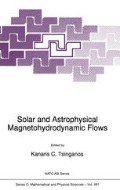Abstract
Any effort to self-consistently model MHD flows encounters prohibitive mathematical difficulties and several simplifications need to be adopted. One common such technique is the so-called self-similar approach where the physical variables are factorized and a suitable scaling law is chosen along a prescribed direction. For example, the well known axisymmetric, and radially self-similar solution of Blandford and Payne (1982) has been widely used to model winds from accretion disks, although it is pathogenic at the flow axis. Here we review a complementary wide class of axisymmetric MHD solutions for rotating magnetized flows which are latitudinally self-similar and are appropriate to model flows from central gravitating bodies, while they do not have the limitations of the radially self-similar ones. in one subclass the streamline pattern is selfconsistently calculated while in the other it is a priori prescribed to correspond to Outflows of various degrees of collimation. The main features of these two subclasses of latitudinally self-similar solutions are presented. A quantitative energetic criterion is also derived saying roughly that when the magnetorotational energy density exceeds the thermal energy density, the flow cross sectional area undergoes oscillations before it finally collimates in a jet of several Alfvén radii width and finite Alfvén number in the range of about 1–100. If on the other hand, the thermal energy density exceeds the magnetorotational one, the asymptotic channel cross sectional area and Alfvén number are much larger and the outflow resembles more to the classical picture of a thermally driven wind. A simple relation is given relating the width of the beam with the terminal Mach number in realistic jet-type flows found for a wide range of the values of the parameters. The evolutionary history of the morphology of outflows from the protosun to the present date Ulysses-measured solar wind, is also sketched within the model. The advantages and limits of the self-similar approach are also discussed.
Access this chapter
Tax calculation will be finalised at checkout
Purchases are for personal use only
Preview
Unable to display preview. Download preview PDF.
References
Belcher J.W. and MacGregor K.B. 1976, Ap. J., 210, 498
Blandford R.D. and Payne D.G., 1982, M.N.R.A.S., 199, 883
Contopoulos J. and Lovelace R.V.E., 1994 Ap. J., 429, 139
Heyvaerts J. and Norman C., 1989, Ap. J., 347
Hu Y.Q. and Low B.C., 1989, Ap. J., 342, 1049
Kudoh T. and Shibata K., 1995 Ap. J. (Lett.), 452, L41
Lima J.J. and Priest E., 1995, Astr. Ap., in press
Lovelace R.V.E., Berk H.L. and Contopoulos J., 1991, Ap. J., 379, 696
Low B.C. and Tsinganos K., 1986, Ap. J., 302, 163
Michel, F.C., 1969, Ap. J., 158, 727
Parker E., 1958, Ap. J., 128, 664
Parker E., 1963, Interplanetary Dynamical Processes, Interscience, New York
Pelletier G. and Pudritz R.E., 1992, Ap. J., 394, 117
Rosso F. and Pelletier G., 1994, Astr. Ap., 287, 325
Sauty C., 1994, Ann. Phys. Fr., 19, 469
Sauty C. and Tsinganos K., 1994, Astr. Ap., 287, 893
Sauty C., Tsinganos K. and Trussoni E., 1995, in Disks and Outflows around Young Stars, in press
Trussoni E. and Tsinganos K., 1993, Astr. Ap., 269, 589
Tsinganos K., 1982, Ap. J., 253, 775
Tsinganos K. and Low B.C., 1989, Ap. J, 342, 1028
Tsinganos K. and Sauty C., 1992, Astr. Ap., 257, 790
Tsinganos K. and Trussoni E., 1991, Astr. Ap., 249, 156
Tsinganos K., Trussoni E. and Sauty C., 1992, in The Sun: A Laboratory for Astrophysics, T.E. Schmeltz and J.C. Brown Eds., Kluwer Academic Publishers, Dordercht, p. 349.
Weber E.J. and Davies L., 1967, Ap. J., 148, 217
Author information
Authors and Affiliations
Editor information
Editors and Affiliations
Rights and permissions
Copyright information
© 1996 Kluwer Academic Publishers
About this chapter
Cite this chapter
Trussoni, E., Sauty, C., Tsinganos, K. (1996). Exact MHD Solutions for Self-Similar Outflows. In: Tsinganos, K.C. (eds) Solar and Astrophysical Magnetohydrodynamic Flows. NATO ASI Series, vol 481. Springer, Dordrecht. https://doi.org/10.1007/978-94-009-0265-7_17
Download citation
DOI: https://doi.org/10.1007/978-94-009-0265-7_17
Publisher Name: Springer, Dordrecht
Print ISBN: 978-94-010-6603-7
Online ISBN: 978-94-009-0265-7
eBook Packages: Springer Book Archive

